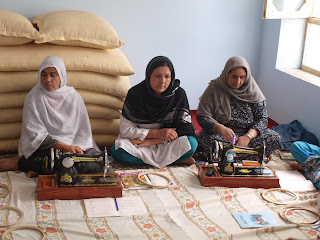The disintegration of families and communities over the past three decades of conflict has resulted in extreme poverty and isolation for many thousands of Afghan women. War, drought, and illness have left many women widowed - struggling to provide for their families without adequate education or training. Combined with the repressive restrictions on women in society, many widows, forced to assume the responsibility of heads of households, have been unable to undertake even the most basic tasks such as going to the market or selling their goods. Religious restrictions have confined many women to their homes and, without husbands or male relatives, they are often left to starve or beg on the streets. Providing women with the skills and resources to gain control over income and earning is crucial to rebuilding the social and economic fabric of Afghanistan. Afghanistan Women’s Council Mission Statement (www.afghanistanwomencouncil.org)
The Afghan Women’s Council is a non-governmental, non-political, non-profit, non-sectarian charity organization founded in Peshawar, Pakistan in 1986 to support Afghan refugee women. AWC empowers Afghan women by building their capacity, improving their health, education and living conditions and strengthening their socio-economic status. AWC moved its operations to Afghanistan in 1992 and now has provincial offices in four provinces with plans to expand to four more provinces in the next two years. Since its inception, the AWC has trained 8,000 women and provided them with microfinance loans to establish their own businesses. Every week, 40 more women receive microfinance loans.
The AWC trains illiterate, unskilled, isolated women and girls to read and write and to learn a livelihood skill like tailoring, sewing, beekeeping, jam and pickle-making, and carpet weaving. For the first three months of the AWC training course, the widows and girls learn to read and write. In the fourth month, the women add a job skills training course to their literacy studies. At the end of the one-year course, the women graduate from the AWC training, and each woman receives a loan of 6,000 Afs ($130 USD) to start her own business.
The Parwan AWC opened its doors in June 2008 and in June 2009, graduated 50 Afghan women from its first training class. The second training class of 50 women graduated on June 27, 2010 (www.afghanistanwomencouncil.org/news.htm). 100% of the women who have graduated from the Parwan AWC one-year training course have repaid their loans and many have received a second loan.
In Parwan province, men are unlikely to allow their wives and daughters to leave home, to attend school, or to embark on a business. It is an enormous achievement that the Parwan AWC has enabled 100 women to date to achieve literacy, acquire a skill, and start a small business. The AWC first works with the men in the lives of the women and girls in their training courses to show them that the AWC is a safe place where the women and girls are well taken care of and that nothing subversive or against Islam goes on there. Men are invited to inspect the Center and observe classes to ensure that they are comfortable allowing their wives and daughters to attend. If the men will not come to the Center, the AWC asks local community and religious leaders to intervene with the husbands/fathers to secure their permission for their wives/daughters to come to the Center.
The women who attend classes at the Parwan AWC are nurtured and supported from their first day at the AWC through their post-graduate period. The AWC provides each woman $20/month for transportation to and from the Center while they are attending classes. Most of the women live in remote villages in the foothills surrounding Parwan. If a woman becomes sick, the Center finds medical care for her. (Many Afghan men believe women should not receive medical attention and refuse their wives and daughters medical care.) The Center provides the women with warm clothing in winter. And they provide an educational facility where children are educated, readied for school, and cared for every day by a staff of three dedicated teachers while their mothers attend classes. The AWC stays in touch with the women after they graduate.
There is a proven link between the empowerment of women and the strengthening of civil society. An income-generating woman invests 90% of her income in her family. That investment, in turn, feeds and educates girls and boys, increases the family’s standard of living, and promotes gender equality within marriages.




